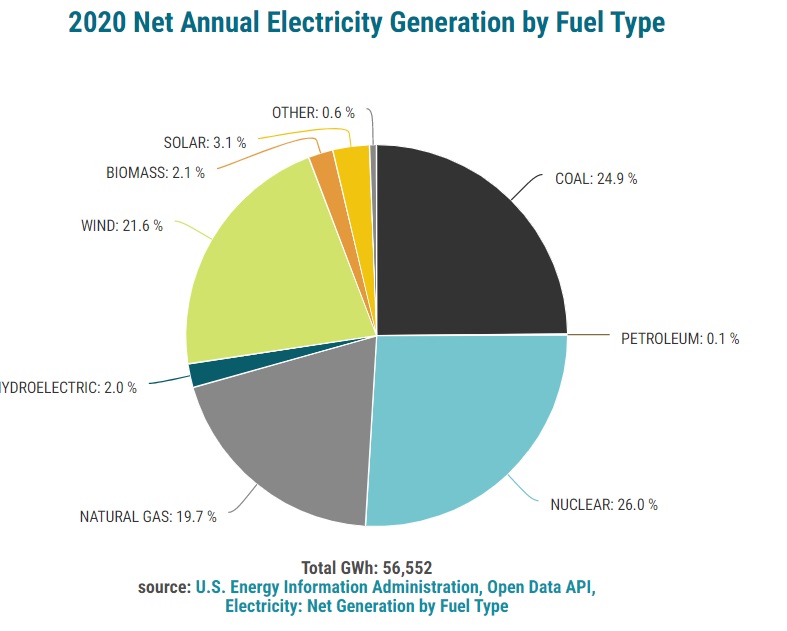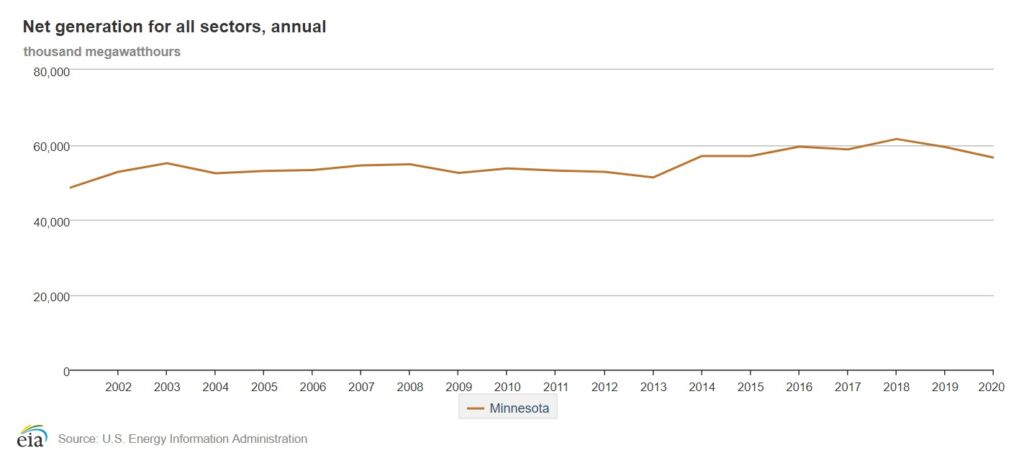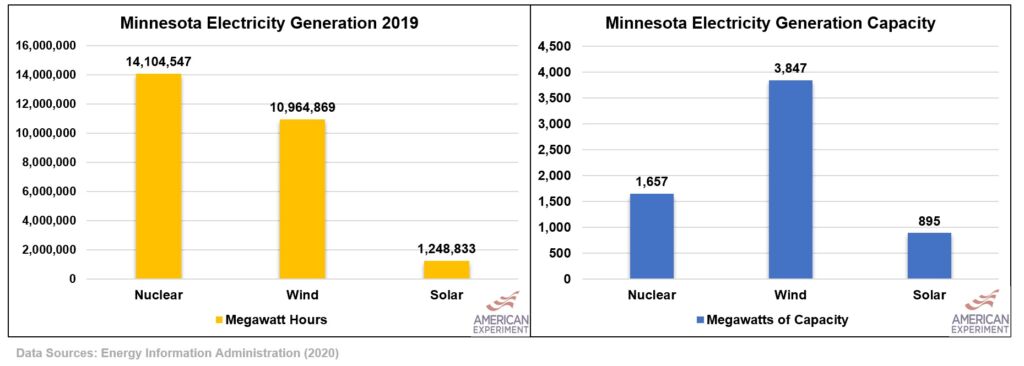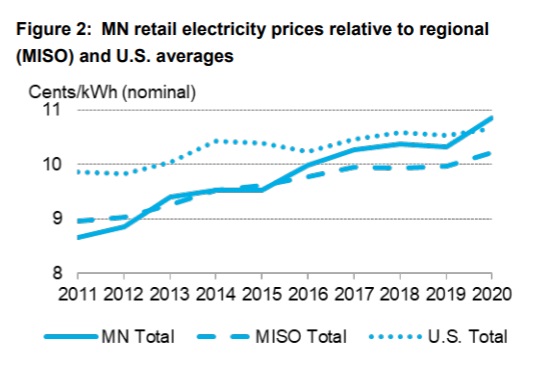Pursuit of wind and solar is not an economic opportunity, it is a liability
Last week, Neal St. Anthony wrote a piece in the Star Tribune called “Zero-carbon electricity now provides most power in Minnesota,” where he describes Minnesota’s pursuit of wind and solar power as an economic opportunity for the state.
Unfortunately, this is not the case. Increasing penetrations of wind and solar have caused electricity prices to rise, which is reducing economic prosperity in our state and even causing some companies to pack up shop and leave for other areas.
St. Anthony’s piece was heavily based on a new report from Bloomberg New Energy Finance that was commissioned by Clean Energy Economy Minnesota, a renewable energy special interest group that also creates a deceptive “clean jobs” report that does not count nuclear plant jobs as “clean jobs.”
Carbon Free Electric Grid
Minnesota’s electric grid is increasingly supplied by sources of electricity that don’t emit carbon dioxide, but nuclear power is still the single largest component of these sources, as you can see in the pie chart below.
St. Anthony groups all of the renewables together to claim they are the largest source of electricity in the state, but we believe this grouping is not the most accurate way to frame Minnesota’s electricity generation. If we wanted to do our own selective grouping, we could add natural gas and coal generation together and accurately claim that fossil fuels provide the most electricity to the grid.
Grouping electricity sources together opens the door for subjective presentations of the data, which is why it is best to simply tell it as it is, nuclear power plants generated the most electricity in Minnesota in 2020, followed by coal, wind, natural gas, and everything else was an “also-ran.”

St. Anthony is correct to note that wind and solar are the fast-growing segments of the electric grid, stating: “Of the 588 megawatts of new generation capacity built last year, all was in solar and wind.” However, there is a lot less importance to this fact that St. Anthony ascribes to it.
Electricity consumption in Minnesota has been relatively stagnant for years, which means there has not been a reason to build new power plants of any variety, whether it be coal, natural gas, wind, solar, or nuclear. Building wind turbines and solar panels has been a purely political decision, not one based on electricity demand.

It’s also important to look at the value of competing types of power plants. For example, nuclear plants are much more productive than wind turbines or solar panels, producing much more electricity per unit of installed capacity.
The additional bonus of nuclear power is that humans control when the power is generated and we are not subject to the whims of the weather. This makes each nuclear, coal, and natural gas power plant much more valuable to system reliability than wind or solar facilities.

California, Texas, and the Southwest Power Pool have recently faced the consequences of relying too heavily on wind, solar, natural gas backup, and energy imports from other states.
The unequivocal truth is this: building a lot of wind turbines and solar panels is no guarantee that they will produce electricity when it is needed most.
Environment
Emissions of carbon dioxide have fallen as natural gas and wind have displaced coal generation. Here, St. Anthony discusses criticisms of natural gas because of methane flaring in North Dakota, but he does not discuss the fact that most of the world’s solar panels come from China, where the Communist Party of China has enslaved Uighur Muslim minorities and forced them to labor in solar panel factories that are powered by cheap, reliable coal-fired electricity, according to a recent New York Times article.

If Minnesotans are to have an informed view on energy policy, the origins and emissions of Chinese solar panels merit as much column space as flaring in North Dakota.
Electricity Prices
Minnesota’s electricity prices are 10.8 cents per kilowatt-hour, which was correctly noted in the original article. However, this fails to tell the whole story. Minnesota’s electricity prices were once 20 percent below the national average.
Now, our electricity prices have surpassed the national average, and are higher than the average price in the regional grid to which Minnesota belongs, the Midcontinent Independent Systems Operator (MISO).
St. Anthony makes a mistake in his article when he compares Minnesota’s electricity prices to those of the MISO region:
Minnesota average electricity prices of 10.8 cents per kilowatt-hour are slightly above the Midcontinent Independent System Operator (MISO) regional average of 10.7 cents.
The graph below, taking from the report St. Anthony draws heavily upon, shows it is the national average which is 10.7 cents per KWh, and the MISO average is 10.21 cents per KWh, as you can see in the graph below.

Minnesota’s electricity prices were once below the national average, and the MISO average, but now our electricity prices are higher than both.
Rising electricity prices are now a competitive disadvantage instead of an asset. High electricity costs were a major reason Verso paper shuttered some of its Minnesota operations. Unfortunately, Minnesota’s high energy prices and high taxes make it a less attractive place to do business than it was 20 years ago.
Creating “Clean Energy Jobs”
Claims that energy policies designed to promote wind and solar are creating a panacea of so-called “clean energy” jobs are also highly misleading. The vast majority of these jobs are not in the wind and solar industry, they are jobs in the HVAC industry and jobs installing and manufacturing energy-efficient windows and doors.
These are important jobs, but it is foolish to think that public policy had anything to do with their existence. This is simply a number created by a special interest group to make it appear as if wind and solar are an economic engine in the state when more than 70 percent of “clean energy jobs” have nothing to do with generating electricity, as you can see in the charts below.

Interestingly, this “clean jobs” report does not include the 1,814 people currently employed in Minnesota’s nuclear industry. It does not make sense to exclude nuclear power from these jobs numbers, because nuclear power provides the majority of the state’s carbon-free electricity.
Missing Greenhouse Gas Targets
Minnesota is indeed missing its greenhouse gas emissions reduction targets. This is because these targets were set by grandstanding politicians, and were not realistic and achievable targets developed by engineers who sought to estimate the cost of achieving the goals.
As a result, Minnesota will likely continue to miss its targets, but it is important to understand what that really means as it relates to future global temperatures. Even if Minnesota achieved net-zero carbon dioxide emissions tomorrow, it would avert just 0.003° C by 2100, an amount far too small to measure with the most sophisticated scientific equipment.

It is crucially important that Minnesotans understand what they are paying for when electricity prices rise to reduce emissions because the ultimate difference in global temperatures would be very small even if Minnesota could meet their politically driven emissions reductions.
There are serious negative impacts from policies that increase the cost of energy. Among the worst impacts are rising electricity prices for low-income rural and minority communities, who pay much more for their energy, as a percentage of their income, than affluent urbanites and suburbanites—all for zero measurable environmental benefits.

Decarbonization is not the economic opportunity St. Anthony paints it to be. As long as efforts to reduce emissions rely upon unreliable wind and solar, it promises to increase the cost of electricity in the state and harm economic growth.